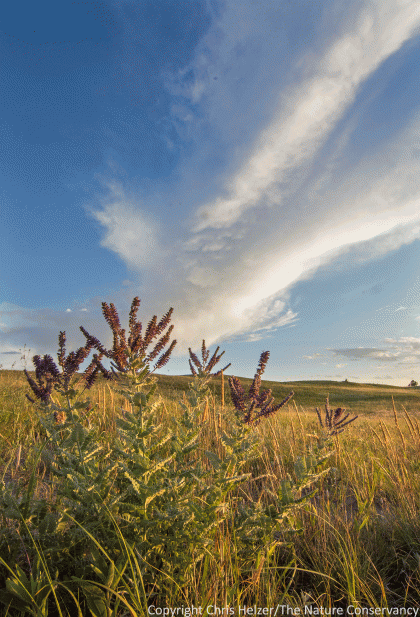(See the note at the end of this post about our free Plant Identification workshop this Thursday – July 6, 2017)
Last week, my wife and I were both at the Niobrara Valley Preserve, working with other staff to evaluate some of our fire and grazing treatments. We finished the bulk of the data collection by Wednesday, but Kim and I stuck around another couple days after the other visiting staff left. On Wednesday evening, we both felt like spending some quiet time in the prairie by ourselves so we took off in opposite directions. As it happened, neither of us got to be alone on our hikes.
I took my ATV up into the hills to find a nice place to walk with my camera as the sun went down, and as I was driving up the hill, I felt something me on the top of the head. It felt like I was driving through tall grass that was slapping me gently as I drove through, but all the vegetation around me was knee high or less. I couldn’t figure out what was going on until I stopped and got off the ATV. At that point, I realized I was being swarmed by some kind of tiny insect.
It was an almost perfectly calm evening, and there were myriad hovering swarms of these insects scattered around the prairie – often over the top of fence posts or tall shrubs. Whenever I came close to one of these swarms, it was like my head was a magnet; the whole swarm would kind of just SHLOOOP over to my head and use it as the center for their wild dance. It was like having my head inside a bubble full of flying bugs. While I was having this surreal experience, Kim was dealing with the same phenomenon a mile away, as she walked along a two-track road through the bison pasture.
I was trying to photograph the beautiful sky and look for flowers or insects, but it was really hard to concentrate with a horde of little critters flying around and crawling about on my head. They weren’t biting me, but they were awfully distracting. If I moved fast enough (the ATV was handy…) I could get away from one swarm, but there were so many swarms around, it would just take a few moments after I stopped before another found me. Once I figured out I wasn’t being attacked, I could relax a little and managed to get some photography done, but I was certainly less focused (ha ha) than normal.
I was, of course, also interested in what kinds of insects these were that were swarming around my head, but they were so tiny I couldn’t see them well enough to tell. I could grab a few of them at a time and look, but I just couldn’t see enough features without some magnification. They didn’t look like midges, which had been my first guess, but beyond that, I was stumped. Finally, as I was getting ready to head back to the cabin, I caught a bigger one (a female, I assumed) and it looked a lot like a winged ant. I took her and few other smaller ones back to the cabin in a little ziplock bag so I could look more closely at them.
The next morning, I pulled the insects out of the bag and used my macro lens to examine and photograph them. Sure enough, they were tiny ants.
As I understand it, the kind of nuptial flights Kim and I experienced are often triggered by a combination of temperature and recent rains (it had rained the previous night). Winged males and a few females take to the sky to chase each other around and mate. Because of the huge number of flying insects in these swarms, they are an easy target for flying predators like dragonflies and birds. Sure enough, Kim said she ran across bunch (flock? squadron?) of hunting dragonflies and they did a pretty good job of thinning the horde of ants around her head. I didn’t think of looking for dragonflies. Instead, as soon as the light dimmed and closed the photography window I hopped on the ATV and gunned it, enjoying a nice manufactured breeze all the way back to the cabin.
I wish the ants luck with their mating swarms. We need ants, and if this is how we get more, then I hope they are successful. At the same time, it’d be nice to have a schedule of when they plan the events so we can plan our quiet evening excursions accordingly…
REMINDER: On July 6 (THIS THURSDAY!) we are hosting a Plant Identification workshop at the Platte River Prairies. This is a free event. Bring your own lunch and water bottle, but we’ll provide snacks and some cold drinks. You can come and go anytime between 9am and 2pm. We will have several expert botanists leading hikes through different habitat types and working with you to improve your plant identification skills. Meet at The Nature Conservancy’s Derr House – 2 miles south of Interstate 80 Exit 300 (Wood River). Immediately after the highway curves sharply to the east, turn south on the gravel road (Platte River Drive) and you’ll see the TNC sign and big brick house. Don’t use your GPS, it’ll likely lead you astray. See you Thursday!







